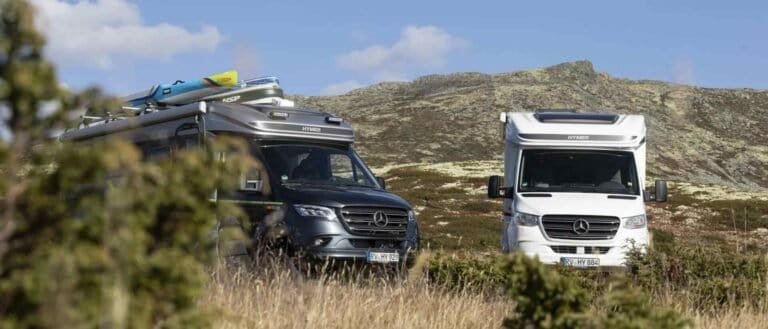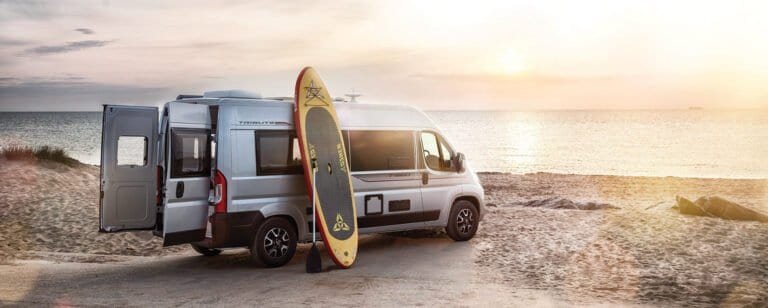Introduction
As interest in road trips and camping continues to grow, campervans and motorhomes have become popular choices for travellers seeking freedom and flexibility. While both offer the ability to explore and stay on the move, they’re far from identical. Campervans and motorhomes differ in size, amenities, cost, and intended use, making each suited to specific types of travellers and travel styles. Understanding these key differences can help you decide which type of vehicle is the best fit for your adventures on the road.
This guide explores the essential distinctions between campervans and motorhomes to help you make an informed choice for your next big trip. We also have another guide on the essential questions to ask before you buy a motorhome or campervan.
1. Size and Layout
One of the main differences between campervans and motorhomes is their size and layout. These factors can affect not only comfort but also ease of driving and parking, which can influence the type of travel you plan to do.
- Campervans: Typically, campervans are more compact and are built on the chassis of standard vans. Due to their smaller size, campervans tend to be more agile and easier to handle on the road. The layout in a campervan is designed to maximise space but generally includes only the basics: a bed, compact kitchen facilities, and limited storage. Sleeping areas may be foldable or convertible, while storage space is often found under the bed or in small compartments.
- Motorhomes: Motorhomes are usually larger and more spacious, designed for travellers who want a comfortable experience similar to home. Built on heavy-duty truck or bus chassis, motorhomes offer more room for amenities and can even accommodate features like bathrooms, larger kitchens, and dedicated living spaces. Many motorhomes also include slide-out sections that expand the interior when parked, providing extra space for cooking, dining, and sleeping.
In summary, campervans are smaller and more minimalist in layout, ideal for shorter trips or solo travel. Motorhomes, on the other hand, offer greater space and comfort, making them suitable for families, long-term trips, or travellers seeking a home-like experience on the road.
2. Amenities and Comfort
The level of amenities and comfort is another significant difference between campervans and motorhomes. Campervans are designed to provide essential conveniences, while motorhomes offer more advanced comforts.
- Campervans: These typically come with basic amenities, such as a small kitchenette and a bed, but usually lack a bathroom and shower. Many campervans have a portable stove, small fridge, and perhaps a sink, but the limited space means less room for full-sized appliances. If you prefer a simple, “back-to-basics” travel experience, a campervan may suit you well. Some newer or customised campervans offer upgraded amenities, such as small toilets or outdoor showers, but these are not standard.
- Motorhomes: Motorhomes often come with all the amenities needed for extended or full-time living. They generally include a full kitchen with a stove, oven, fridge, and microwave, along with a bathroom that has a toilet and shower. Larger motorhomes even feature separate living and sleeping areas, providing a much higher level of comfort. This makes motorhomes an excellent choice for travellers who want more than just basic conveniences or for those who intend to spend significant time on the road.
Overall, if comfort and convenience are priorities, especially for longer trips or with a group, motorhomes offer a more home-like environment with amenities that make day-to-day life easier.
3. Driving and Manoeuvrability
Another crucial difference between campervans and motorhomes is the ease of driving and manoeuvring. This can impact your travel experience, especially when navigating narrow roads, busy areas, or unfamiliar terrain.
- Campervans: Due to their smaller size, campervans are generally easier to drive, park, and handle in tight spaces. Built on standard van chassis, they feel similar to driving a large car, which can be less intimidating for beginners. Their compact size also makes them more versatile for exploring narrow roads, rural areas, and cities where parking can be limited. Campervans are ideal for those who prioritise flexibility and agility on the road.
- Motorhomes: Driving a motorhome can feel more like operating a small bus or large truck, especially with Class A or larger Class C models. Their size makes manoeuvring in tight areas or parking in urban spaces more challenging, and some drivers may require additional training or practice to feel comfortable behind the wheel. Longer motorhomes may even be restricted on certain roads, so route planning is essential. However, many motorhomes now come equipped with driving aids like backup cameras and parking sensors, making the driving experience easier.
In short, campervans offer greater agility and are suited for drivers who want a more car-like experience, while motorhomes are larger and may require more driving skill and awareness, especially in crowded or narrow spaces.
4. Fuel Efficiency and Maintenance Costs
Fuel efficiency and maintenance are essential considerations, as they affect the overall cost of owning and operating a campervan or motorhome. Generally, campervans are more economical in both areas.
- Campervans: Thanks to their smaller size and lighter weight, campervans tend to have better fuel efficiency than motorhomes. Built on regular van frames, they can average around 10-15 litres per 100 kilometres (depending on the model and driving conditions). This lower fuel consumption makes campervans a more budget-friendly option for frequent travellers or those planning longer trips. Maintenance for campervans is typically simpler as well, with standard car parts that are less expensive to repair or replace.
- Motorhomes: Due to their size and weight, motorhomes consume more fuel, with larger models averaging closer to 20-30 litres per 100 kilometres. This can be a significant cost factor, especially on extended road trips. Motorhomes also have additional components, such as generators, large appliances, and complex electrical or plumbing systems, which require regular maintenance and may result in higher repair costs over time. Motorhome parts are often larger and heavier-duty, adding to the cost of repairs.
If fuel economy and lower maintenance expenses are priorities, a campervan may be the better choice. However, if you’re willing to trade some economy for extra space and comfort, a motorhome may be worth the added expense.
5. Intended Use and Travel Style
How you plan to use your vehicle and your preferred travel style are key factors in choosing between a campervan and a motorhome. Both types are designed for different kinds of journeys and can offer distinct advantages depending on your travel needs.
- Campervans: Campervans are ideal for shorter trips, weekend getaways, or travellers who enjoy a more minimalist, flexible style of travel. Their smaller size and simpler setup make them perfect for exploring different destinations at a quicker pace, whether it’s city hopping, coastal trips, or exploring remote areas. Since campervans are typically more compact, they’re a great fit for solo travellers or couples who don’t need a lot of living space and are happy with basic amenities.
- Motorhomes: Motorhomes, with their larger space and home-like features, are better suited for long-term travel, extended holidays, or even full-time living. They’re perfect for families, groups, or individuals looking for more comfort and who want to bring the conveniences of home on the road. A motorhome is ideal if you plan to stay at one destination for longer stretches, as it allows you to settle in comfortably. It also makes off-season travel easier, as you can keep warm in colder weather and still have amenities like a kitchen and bathroom.
If you’re planning on frequent, shorter trips or you prefer a more adventurous, minimalist style of travel, a campervan is likely a better fit. On the other hand, if you’re considering long-term travel or want a more luxurious travel experience, a motorhome provides greater comfort and convenience.
6. Price Range and Financing Options
The initial cost and potential financing options for campervans and motorhomes vary significantly. Each option has distinct price ranges and considerations that can influence your decision.
- Campervans: Campervans tend to be the more affordable option, with prices for new models generally starting around €30,000 and going up to €60,000 or more for high-end models. Used campervans offer even more budget-friendly options, with prices depending on age, condition, and customisations. Financing options for campervans are often available through banks or financing with lenders through dealerships, especially for new purchases. Because of their lower cost, campervans can also be easier to insure and may incur lower monthly payments if you’re using a loan.
- Motorhomes: Motorhomes are a more significant investment, with new models typically ranging from €50,000 for smaller, basic models up to €150,000 or more for larger, luxury models. These vehicles may offer specialised financing options through dealerships or RV financing companies, which often allow for extended payment terms. Due to the high upfront cost, insurance and repairs for motorhomes can also be more expensive. However, if you plan to travel extensively or make the motorhome your primary residence, the additional cost may be worthwhile for the comfort and amenities provided.
In general, campervans are a lower-cost entry point into road travel, while motorhomes require a larger investment but provide a more comprehensive living experience. Check out our comparison of new vs used campervans and motorhomes.
Conclusion
Choosing between a campervan and a motorhome ultimately comes down to your travel needs, lifestyle preferences, and budget. Campervans are a great choice for those seeking agility, flexibility, and a more affordable entry into road travel. They offer a simpler setup, lower fuel costs, and are easier to drive and park, making them ideal for short trips or minimalist travel styles.
Motorhomes, on the other hand, provide a comfortable and spacious living environment, making them better suited for longer trips, family travel, or even full-time living. While they require a larger investment and more driving experience, their amenities and home-like features bring added comfort and convenience for extended stays.
Whether you’re looking for quick weekend getaways or a full-time home on the road, understanding the differences between campervans and motorhomes will help you make the right choice and enjoy your adventures to the fullest. For more help, you can read more in our guide on choosing the perfect campervan or motorhome.
FAQs
1. What is the main difference between a campervan and a motorhome?
The primary difference lies in their size and amenities. Campervans are smaller, typically with only basic amenities like a bed and a small kitchenette, while motorhomes are larger and more equipped, often including full kitchens, bathrooms, and living areas.
2. Are campervans or motorhomes more expensive?
Motorhomes are generally more expensive due to their larger size and additional amenities. Campervans are more affordable, with new models typically ranging from €30,000-€60,000, whereas motorhomes can start at around €50,000 and reach up to €150,000 for luxury models.
3. Which is easier to drive, a campervan or a motorhome?
Campervans are easier to drive and park because they are smaller and handle similarly to a large van. Motorhomes are larger and may feel more like driving a bus or truck, requiring more skill, especially in tight spaces.
4. Are there licensing requirements for driving a motorhome in Ireland?
In Ireland, a standard licence allows you to drive vehicles up to 3.5 tonnes. For larger motorhomes over 3.5 tonnes, a C1 licence is required, so it’s important to check the weight of the vehicle you’re considering.
5. Which option is better for long-term or full-time living?
Motorhomes are generally better suited for long-term or full-time living because of their larger space, separate living areas, and full amenities. They offer more comfort and convenience, especially for families or those looking for a home-like experience.
6. What are the fuel costs like for campervans compared to motorhomes?
Campervans are typically more fuel-efficient, averaging around 10-15 litres per 100 kilometres. Motorhomes, being larger and heavier, consume more fuel, often in the range of 20-30 litres per 100 kilometres, which can add to travel costs over long distances.
7. Can I use a campervan or motorhome in all seasons?
Yes, but comfort levels vary. Motorhomes, with better insulation and built-in heating, are more suitable for winter travel. Campervans can be used year-round, but they may lack heating or insulation, making them less comfortable in colder weather.
8. Do campervans have bathrooms?
Most campervans do not have bathrooms due to their limited space. Some campervans may include a portable toilet or an outdoor shower, but for full bathroom facilities, a motorhome is usually the better option.
9. Are campervans good for families?
Campervans can work for small families, but space is limited. Motorhomes are typically better for families due to their larger size and more sleeping options, as well as dedicated living and storage spaces.
10. How much does it cost to insure a campervan versus a motorhome?
Campervan insurance is usually more affordable than motorhome insurance, as campervans are smaller and less costly to repair or replace. Motorhome insurance varies but is typically higher due to the vehicle’s larger size, higher value, and additional amenities.







